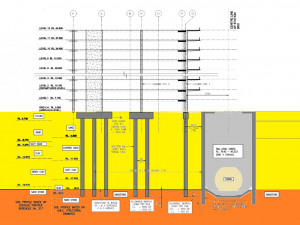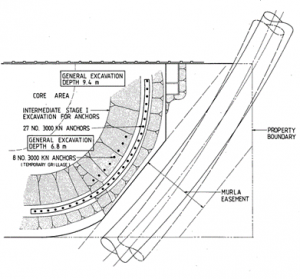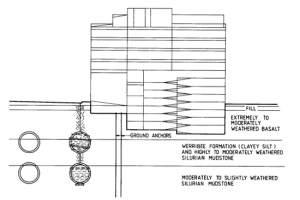Seminar Chair, Ted Nye, a specialist in major underground infrastructure design and construction, explains why it is very important that approval authorities, urban planners, developers, architects, geotechnical and structural engineers, understand that the proximity of an existing tunnel can impact on the development potential of a site nearby.
My experience with this increasingly important topic of building around existing tunnels goes back to my days working on the Melbourne Underground Rail Loop (MURL) in the mid-1980s. Together with Tony Bennett from Aurecon, I presented a paper titled Excavation Adjacent to Tunnels in Rock at the Finite Element Methods in Engineering Conference in Melbourne in 1987. There, the unique mitigation method was vertical tensioned ground anchors near the boundary with the tunnel to minimise rock mass elastic rebound due to deep basement excavations.
A more recent paper from 2018 (reference 1) related to issues of water ingress into MURL tunnels, makes an interesting read and highlights the sensitivity to ground movement and the long-term performance of concrete linings – depending on the ground conditions and whether they have steel reinforcement or not.
One thing to realise from the very start is that every case is unique. Neither generic standards nor standard solutions can ever be applied in a blanket way. This is why it is vitally important that anyone planning underground works has a basic understanding of what pitfalls and challenges they might face if their development is near an existing tunnel.
This is the background context of the Building around existing tunnels seminar, to be held in Sydney on April 27. Attendees will hear from some of Australia’s most experienced practitioners on the topic and gain new knowledge from other people’s experiences. This is a truly multidisciplinary topic, and any project can suffer a drawn-out approvals process because of a lack of knowledge or communication between the stakeholders. One of our objectives is to help prevent unpleasant surprises for anyone involved in such a project.
As an example, geotechnical engineers must appreciate that the assessment of a basement excavation is not just about the geology and rock mass displacement, but also about the potential impact of even small ground movements on a nearby rigid concrete tunnel lining. In my experience, the profile of a nearby tunnel is often ignored in the initial stages of an assessment, but there is a big difference between a circular tunnel and a rectangular shaped tunnel.
The approval authority also needs to be flexible in their approach, especially if no provisions have been made to allow for future urban developments. Minor cracking of concrete does not necessarily impact on the serviceability of a tunnel, many tunnels old and new will have some defects and some tunnels are more sensitive than others. For railway tunnels, overhead wiring and the rails are potentially exposed to corrosion over time in a wet environment due to dripping water and seepage through the tunnel lining. Although it should be noted that more recent segmentally lined railway tunnels in Australia should be more tolerant to ground movement than past in-situ concrete lined tunnels.
Personally speaking, I’m really looking forward to Chairing the Seminar because it is a challenging subject both technically and managerially. From my experience, each project does not follow a fixed set of rules, although I qualify this by saying the approval guidelines are quite rigid in contrast to the engineering first principles approach that is required to assess the potential impact of new developments near existing tunnels.
I look forward to seeing you there and hope you come with interesting questions for our presenters and join in any discussions.
For more information, or to register, visit: Building around existing tunnels seminar
By Ted Nye
6 February 2023
Reference:
- Yuqi Tan et al, “Predicting external water pressure and cracking of a tunnel lining by measuring water inflow rate”, Tunnelling and underground Space Technology, 71 (2018).

Multiple buildings around stations and tunnels on the Airport Line, Sydney.

Plan from the 1987 paper referred to in the text.

Section from the 1987 paper referred to in the text.







